You are viewing the RapidMiner Studio documentation for version 9.9 -Check here for latest version
Using the Azure Data Lake Storage Gen1 Connector
这顾ide targets the new Connection Management introduced with RapidMiner Studio 9.3.
For the old Legacy Azure Data Lake Storage Connections see the9.2 documentation
这顾ide targets the Gen1 Azure Data Lake Storage architecture. For the newer storage architecture see theGen2 documentation
The Azure Data Lake Storage Gen1 Connector allows you to access your Azure Data Lake Storage Gen1 account directly from RapidMiner Studio. Bothreadandwriteoperations are supported. You can alsoread from a set of filesin an Azure Data Lake Storage directory, using the![]() Loop Azure Data Lake Storage Gen1操作符。This document will walk you through how to:
Loop Azure Data Lake Storage Gen1操作符。This document will walk you through how to:
Connect to your Azure Data Lake Storage Gen1 account
Before you can use the Azure Data Lake Storage Gen1 Connector, you have to configure your Azure environment to support remote connections and setup a new Azure Data Lake Storage Gen1 Connection in RapidMiner.
For this purpose, you need to go through the following main steps (see details below).
- Create a web application registration on the Azure portal.
- Acquire information for the remote connection.
- Setup and test the new Azure Data Lake Storage Gen1 Connection in RapidMiner.
Step 1: Create a web application registration on Azure portal
创建和配置一个Azure广告t的web应用程序o allow service-to-service authentication with Azure Data Lake Storage Gen1 using Azure Active Directory. Go throughStep 1toStep 3of theService-to-service authentication guide. The first step registers a web application that will provide access for RapidMiner to Azure Data Lake Storage. Note that you can use arbitrary values for theNameandSign-on URLfields. The second step describes how to get your Tenant ID, the application ID for the registered application, and a key that needs to be provided in RapidMiner so that it is able to use this application. The third step configures this Active Directory application to have access to your Data Lake Storage.
After performing those steps in your Azure Tenant, you should have aweb applicationregistration that is configured to access some or all folders of your target Azure Data Lake Storage Gen1 resource. Note that for the file browser of the RapidMiner operators (see below) to work, you need to giveReadandExecuteaccess on the root directory, and on all directories where you want to allow navigation. Besides that, you needWritepermission to be able to write to the cloud storage from RapidMiner. If you can work without the file browser, you can limit the permissions to the target folders / files that your operators directly use.
Step 2: Acquire information for the remote connection
To create the Connection in RapidMiner, you need to acquire the following information. The previous step and linked guide described how to get them, but let's repeat the direct links here to these details.
- Tenant ID that identifies your company's account.Get Tenant ID.
- Fully Qualified Domain Name of your accont. Example: if your Azure Data Lake Storage Gen1 is named
contoso, then the FQDN iscontoso.azuredatalakestore.netby default. - Application ID and application key for the Web application you created.Get application ID and authentication key.
Step 3: Setup and test the new Azure Data Lake Storage Gen1 Connection in RapidMiner
After you have all information, it is straightforward to set up your Connection in RapidMiner.
In RapidMiner Studio, right-click on the repository you want to store your Azure Data Lake Storage Gen1 Connection in and choose
 Create Connection.
Create Connection.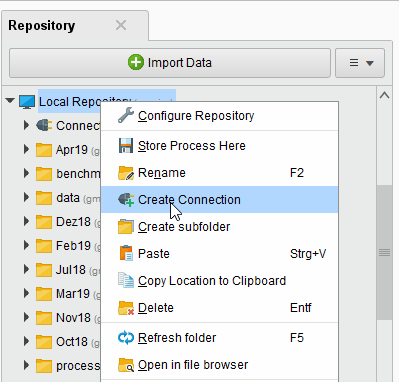
You can also click onConnections > Create Connection
 and select therepositoryfrom the dropdown of the following dialog.
and select therepositoryfrom the dropdown of the following dialog.Give a name to the new Connection, and setConnection Typeto
 Azure Data Lake Storage Gen1:
Azure Data Lake Storage Gen1: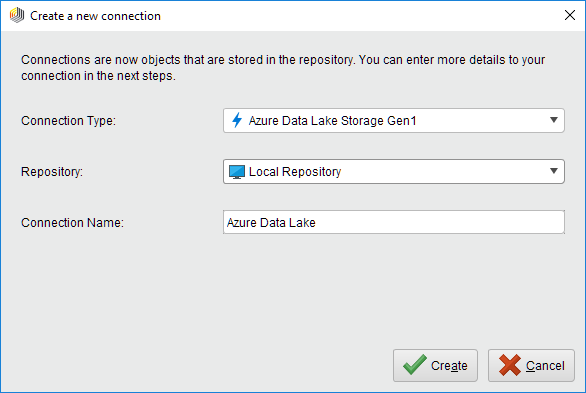
Click on
 Createand switch to theSetuptab in theEdit connectiondialog.
Createand switch to theSetuptab in theEdit connectiondialog.Fill in the Connection details of your Azure Data Lake Storage Gen1 account. Specify theTenant ID,Account FQDN(fully qualified domain name),Client ID(web application ID),Client Key(password to access the web application).
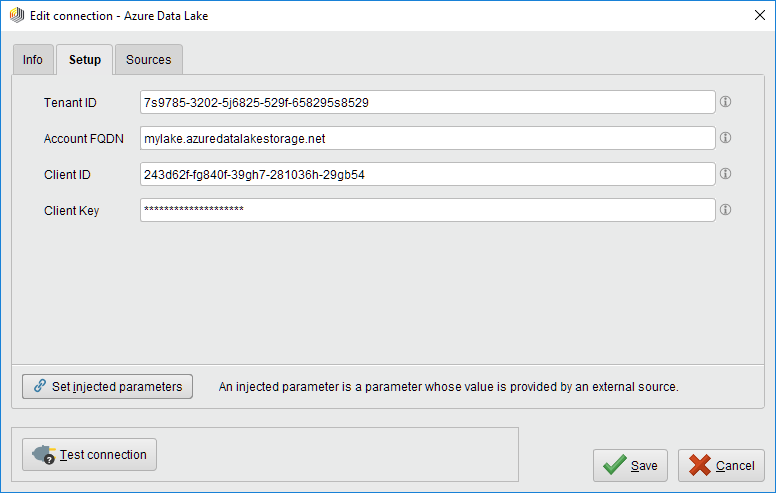
While not required, we recommend testing your new Azure Data Lake Storage Gen1 Connection by clicking the
 Test connectionbutton. If the test fails, please check whether the details are correct.
Test connectionbutton. If the test fails, please check whether the details are correct.Click
 Saveto save your Connection and close theEdit connectiondialog. You can now start using the Azure Data Lake Storage operators.
Saveto save your Connection and close theEdit connectiondialog. You can now start using the Azure Data Lake Storage operators.
Read from Azure Data Lake Storage
The![]() Read Azure Data Lake Storage Gen1operator reads data from your Azure Data Lake Storage Gen1 account. The operator can be used to load arbitrary file formats, since it only downloads and does not process the files. To process the files you will need to use additional operators such asRead CSV,Read Excel, orRead XML.
Read Azure Data Lake Storage Gen1operator reads data from your Azure Data Lake Storage Gen1 account. The operator can be used to load arbitrary file formats, since it only downloads and does not process the files. To process the files you will need to use additional operators such asRead CSV,Read Excel, orRead XML.
Let us start with reading a simplecsvfile from Azure Data Lake Storage.
Drag aRead Azure Data Lake Storageoperator into theProcess Panel. Select your Azure Data Lake Storage Gen1 Connection for theconnection entryparameter from the Connections folder of the repository you stored it in by clicking on the
 button next to it:
button next to it: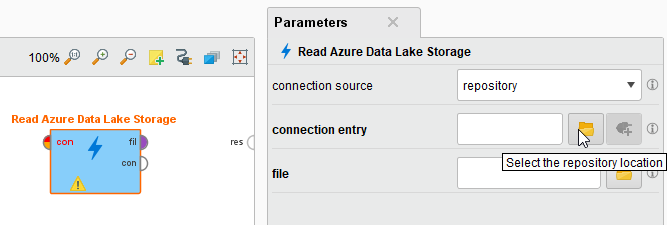
Alternatively, you can drag the Azure Data Lake Storage Gen1 Connection from the repository into theProcess Paneland connect the resulting operator with theRead Azure Data Lake Storage Gen1操作符。
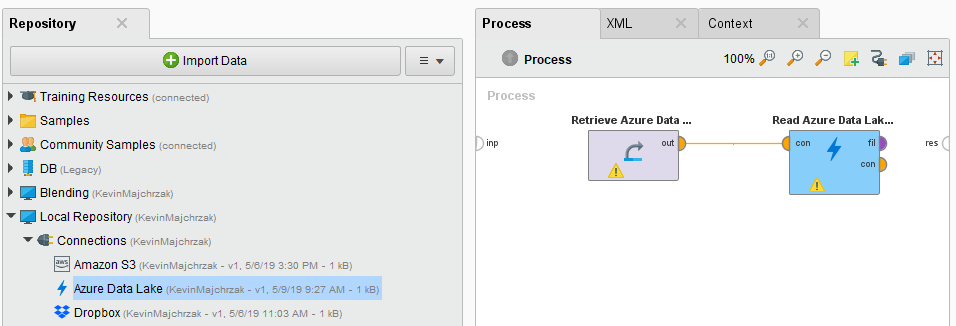
Click on thefilechooser button
 to view the files in your Azure Data Lake Storage Gen1 account. Select the file that you want to load and click
to view the files in your Azure Data Lake Storage Gen1 account. Select the file that you want to load and click Open. Note that you need to haveReadandExecuteaccess to the root directory, if you want to use the file browser starting from the root folder. If you do not have that permission, you can type a path into the parameter field. If you have access to the parent folder of that path (file or directory) andExecuteaccess up to the root folder, you can open the file browser. Or you can always use a manually typed path and use the operator with that (in that case, permission is only checked during runtime).
Open. Note that you need to haveReadandExecuteaccess to the root directory, if you want to use the file browser starting from the root folder. If you do not have that permission, you can type a path into the parameter field. If you have access to the parent folder of that path (file or directory) andExecuteaccess up to the root folder, you can open the file browser. Or you can always use a manually typed path and use the operator with that (in that case, permission is only checked during runtime).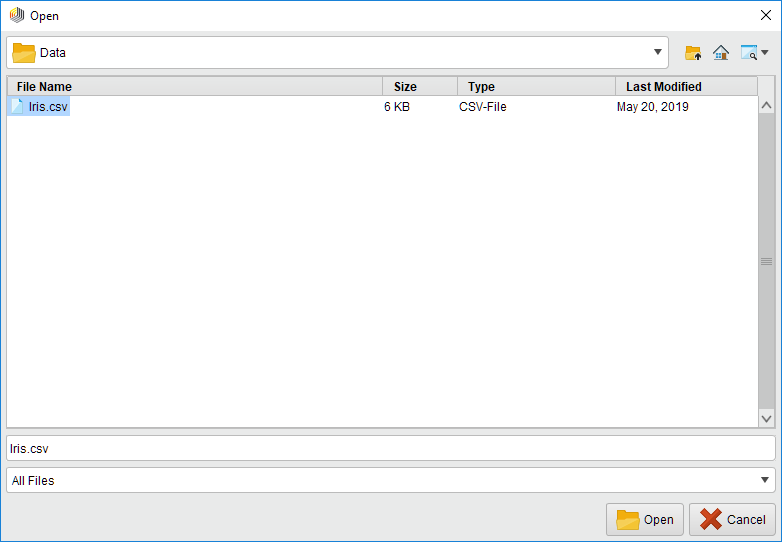
As mentioned above, the
 Read Azure Data Lake Storage Gen1operator does not process the contents of the specified file. In our example, we have chosen acsvfile (acomma separated valuesfile). This file type can be processed via theRead CSV操作符。
Read Azure Data Lake Storage Gen1operator does not process the contents of the specified file. In our example, we have chosen acsvfile (acomma separated valuesfile). This file type can be processed via theRead CSV操作符。Add aRead CSVoperator between the
 Read Azure Data Lake Storage Gen1operator and the result port. You may set the parameters of theRead CSVoperator - such as column separator -, depending on the format of your csv file:
Read Azure Data Lake Storage Gen1operator and the result port. You may set the parameters of theRead CSVoperator - such as column separator -, depending on the format of your csv file:
Run
 the process! In theResultsperspective, you should see a table containing the rows and columns of your choosen csv file:
the process! In theResultsperspective, you should see a table containing the rows and columns of your choosen csv file: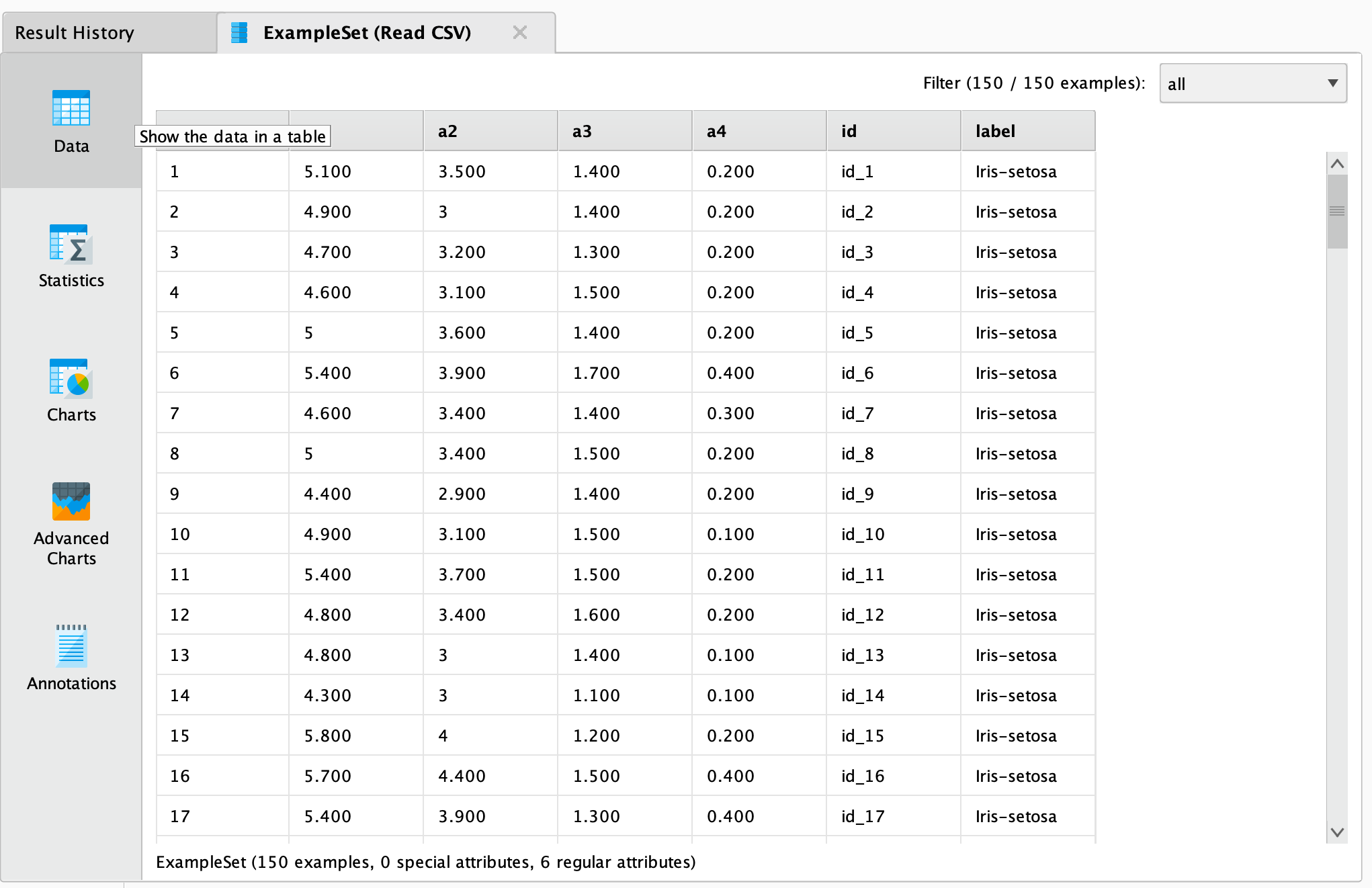
You could now use further operators to work with this document, e.g., to determine the commonness of certain events. To write results back to Azure Data Lake Storage, you can use the![]() Write Azure Data Lake Storage Gen1操作符。It uses the same Connection Type as the
Write Azure Data Lake Storage Gen1操作符。It uses the same Connection Type as the![]() Read Azure Data Lake Storage Gen1operator and has a similar interface. You can alsoread from a set of filesin an Azure Data Lake Storage directory, using the
Read Azure Data Lake Storage Gen1operator and has a similar interface. You can alsoread from a set of filesin an Azure Data Lake Storage directory, using the![]() Loop Azure Data Lake Storage Gen1操作符。对于这一点,你需要指定connection entryand thefolderthat you want to process, as well the steps of the processing loop with nested operators. For more details please read the help of the
Loop Azure Data Lake Storage Gen1操作符。对于这一点,你需要指定connection entryand thefolderthat you want to process, as well the steps of the processing loop with nested operators. For more details please read the help of the![]() Loop Azure Data Lake Storage操作符。
Loop Azure Data Lake Storage操作符。








